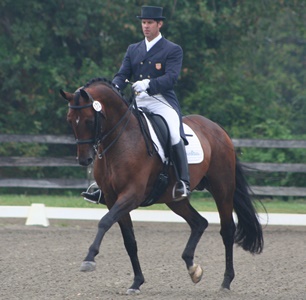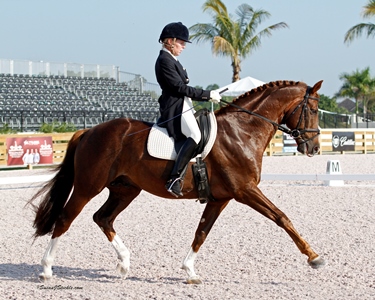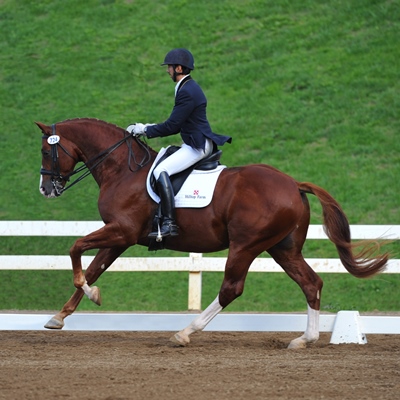 Successfully managing a stallion’s competition and breeding careers requires careful planning. It’s easy to forget that they are essentially being asked to have two distinctly different jobs. Each of his jobs place different physical and mental demands on the stallion and your management approach needs to account for all of those demands.
Successfully managing a stallion’s competition and breeding careers requires careful planning. It’s easy to forget that they are essentially being asked to have two distinctly different jobs. Each of his jobs place different physical and mental demands on the stallion and your management approach needs to account for all of those demands.
For the young horse who is just beginning his breeding and show career, our preference is to have them well-started undersaddle before they begin breeding. Those early months with just a single focus allow the stallion to fully understand one job, the expectations for behavior, and develop a training mindset. While much time is spent with all our young horses on groundwork and manners, extra attention is given reinforcing these lessons with the stallions. Once the stallion understands his role undersaddle, we then can add his second job as a breeding stallion.
Each year we evaluate the plans for every stallion (photo above, Royal Prince). We’ll look first at his training and competition schedule. Peak show season often conflicts with peak breeding season. The anticipated size of a stallion’s breeding book will also be considered. A stallion breeding ten mares a year is under far less pressure than, for example, the stallion breeding fifty mares a year.
Your plan will change from year to year and while our expectation is the dual-career approach, there may be times when one or the other job has to take more of a priority. If a stallion has a particular heavy show schedule or important competitions in a year, we may limit him to a shorter breeding season in a given year or provide incentives for mare owners willing to utilize frozen instead of cooled semen. The use of frozen semen has many advantages, but particularly reduces the demands on the stallion as semen can be collected at a time that is in least conflict with the training/show schedule.
For example, at Hilltop Farm our standard cooled semen season runs from March 1st to August 31st and that of course coincides with our peak show season. To work around this, we have sometimes taken stallions in the winter to Florida. We will delay the start of their breeding season until April, get the majority of their shows done early in the year, and then allow them to just continue to train during breeding season without the added pressure of horse shows. For other stallions, we may only show very lightly during the start of breeding season, but then may end their cooled semen book earlier than our standard. When working towards a major Championship competition or something like a Stallion Performance Testing, you may choose to not breed in the month or so leading up to that event so that the stallion’s focus and physical demands are channeled towards just that one job.
 Likewise, if the stallion’s priority is his breeding duties we will schedule a lighter competition schedule during the breeding season. A heavy collection schedule can be very physically demanding on a horse. Listen closely to what your horse is telling you and adjust your plans accordingly. While we prefer to keep a stallion in training throughout the breeding season, we may need to lighten the work load during this peak breeding time and will utilize bodywork (massage, chiropractic, acupuncture, etc.) as needed.
Likewise, if the stallion’s priority is his breeding duties we will schedule a lighter competition schedule during the breeding season. A heavy collection schedule can be very physically demanding on a horse. Listen closely to what your horse is telling you and adjust your plans accordingly. While we prefer to keep a stallion in training throughout the breeding season, we may need to lighten the work load during this peak breeding time and will utilize bodywork (massage, chiropractic, acupuncture, etc.) as needed.
A stallion’s (photo left, Don Hill) nutritional program (see the article, Feeding the Breeding Stallion) must also be carefully monitored. A heavy breeding schedule and/or heavy travel schedule for competitions will cause some stallions to lose weight and condition. Your equine nutritionist can help you adjust your feeding program to meet these seasonal demands. A slight bit of extra weight going into the start of breeding season can be beneficial for some stallions. However we don’t want them fat; they still need to be fit so that there is less risk of injury (both in breeding and training). Even our stallions that are retired from riding still use a walker or treadmill to help with their fitness levels.
Our breeding shed is a bit of a walk from our main barn where the stallions reside. Not only does the separation of environments help the stallions know what their job focus is at any point, they also get to warm-up their muscles just a little bit on the walk over to the breeding shed. That small warm-up we feel helps avoid injuries when mounting/dismounting the phantom.
 Some stallions come back from the shed invigorated and feeling great in their bodies. Others can get a bit sore or lethargic from frequent collections. Some stallions are more able to focus on their riding work after a collection; while others become more focused on mares and their surroundings instead of their other job. Through trying different schedules, you’ll learn the ideal management for your stallion. Can he be collected just prior to loading and heading to a horse show, or is it better if you include an extra ‘day off’ on his breeding schedule when you know he’ll be headed to a competition? Is it better to ride him before he’s collected or is it fine to ride him later in the day? The answers will be different for each stallion.
Some stallions come back from the shed invigorated and feeling great in their bodies. Others can get a bit sore or lethargic from frequent collections. Some stallions are more able to focus on their riding work after a collection; while others become more focused on mares and their surroundings instead of their other job. Through trying different schedules, you’ll learn the ideal management for your stallion. Can he be collected just prior to loading and heading to a horse show, or is it better if you include an extra ‘day off’ on his breeding schedule when you know he’ll be headed to a competition? Is it better to ride him before he’s collected or is it fine to ride him later in the day? The answers will be different for each stallion.
Every stallion (photo right, Qredit Hilltop) is unique and his specific plan and needs may change a bit from year to year. Managing a dual-career for a stallion has its challenges, but through careful management of the goals, schedule, nutrition, environment, and training your stallion can have excellent success in both jobs.
Photos provided by Hilltop Farm, Inc.


Log in to join the conversation.